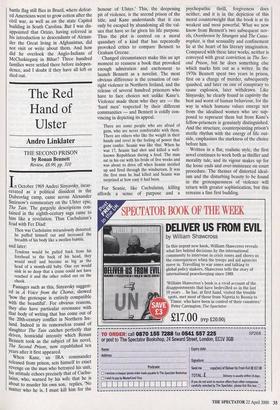The Red Hand of Ulster
Andro Linklater
THE SECOND PRISON by Ronan Bennett Review, f6.99, pp. 310 In October 1969 Andrei Sinyaysky, incar- cerated as a political dissident in the Dubrovlag camp, came across Alexander Smimow's commentary on the Ulster epic, The Tain. The gargoyle descriptions con- tained in the eighth-century saga came to him like a revelation. Thus Cuchulainn's feud with Fer Diad:
Then was Cuchulainn miraculously distorted: he puffed himself out and increased the breadth of his body like a swollen bubble.
and later:
Tendons would be pulled back from his forehead to the back of his head, they would swell and become as big as the head of a month-old baby. One eye would sink in so deep that a crane could not have reached it and the other rolled out on the cheek.
Passages such as this, Sinyaysky suggest- ed in A Voice from the Chorus, showed `how the grotesque is entirely compatible with the beautiful'. For obvious reasons, they also have particular resonance with that body of writing that has come out of the 20th-century conflict in Northern Ire- land. Indeed in its remorseless round of slaughter The Tain catches perfectly that driven, homicidal intensity which Ronan Bennett took as the subject of his novel, The Second Prison, now republished ten years after it first appeared. When Kane, an IRA commander released from prison, sets himself to exact revenge on the man who betrayed his unit, his attitude echoes precisely that of Cuchu- lainn, who, warned by his wife that he is about to murder his own son, replies, 'No matter who he is, I must kill him for the honour of Ulster.' This, the deepening pit of violence, is the second prison of the title, and Kane understands that it can only be escaped by abandoning all the val- ues that have so far given his life purpose. Thus the plot is centred on a moral quandary of a kind that has repeatedly provoked critics to compare Bennett to Graham Greene.
Changed circumstances make this an apt moment to reassess a book that provoked enough admiration and excitement to launch Bennett as a novelist. The most obvious difference is the cessation of out- right violence in Northern Ireland, and the release of several hundred prisoners who have to face choices not unlike Kane's. Violence made them who they are — the `hard men' respected by their different communities — and Bennett is coldly con- vincing in depicting its appeal.
There are some people who are afraid of guns, who are never comfortable with them. There are others who like the weight in their hands and revel in the feeling of power that guns confer. Seanie was like that. When he was 17, Seanie had shot and killed a well- known Republican during a feud. The man sat in his car with his bride of five weeks and was about to drive off when Seanie strolled up and fired through the windscreen. It was the first man he had killed and Seanie was surprised at how easy it had been.
For Seanie, like Cuchulainn, killing affords a sense of purpose and a psychopathic thrill, forgiveness does neither, and it is in the depiction of this moral counterweight that the book is at its weakest and most powerful. What we now know from Bennett's two subsequent nov- els, Overthrown by Strangers and The Cates- trophist, is that sensuality and confinement lie at the heart of his literary imagination. Compared with these later works, neither is conveyed with great conviction in The Sec- ond Prison, but he does something else which marks him out as a writer. In the 1970s Bennett spent two years in prison, first on a charge of murder, subsequently quashed, and later on one of conspiracy to cause explosion, later withdrawn. Like Sinyaysky, he clearly found in captivity the best and worst of human behaviour, for the way in which humane values emerge not from the idealised women who are sup- posed to represent them but from Kane's fellow-prisoners is genuinely distinguished. And the structure, counterpointing prison's sterile rhythm with the energy of life out- side, emphasises the starkness of the choice before him.
Written in a flat, realistic style, the first novel continues to work both as thriller and morality tale, and its vigour makes up for the loose ends and over-insistence on court procedure. The themes of distorted ideal- ism and the disturbing beauty to be found in the grotesquessness of violence will return with greater sophistication, but this remains a fine first budding.


























































 Previous page
Previous page